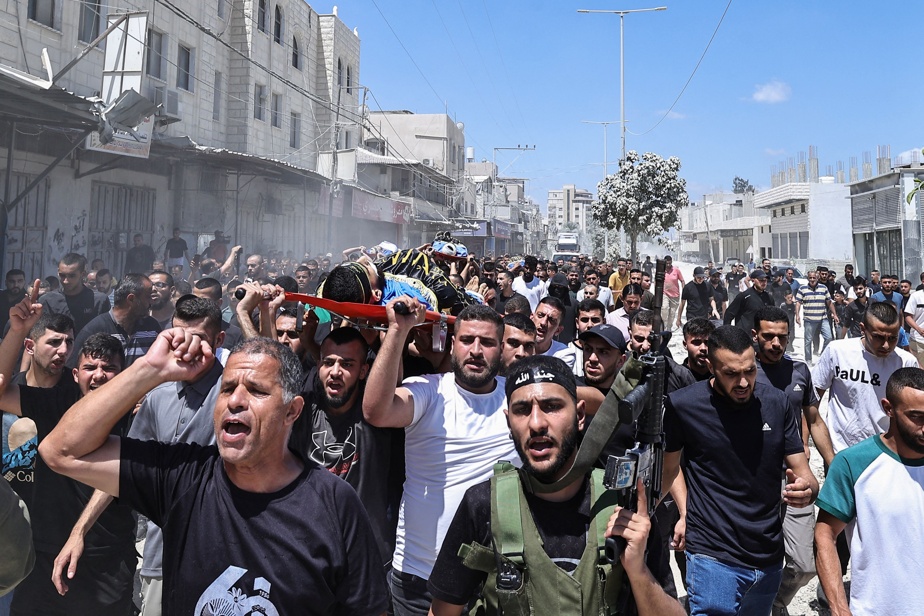Tens of thousands of Palestinians have fled the southern Gaza Strip after an evacuation order from Israel, raising fears of a major new offensive in this part of the Palestinian territory, which was subjected to new Israeli bombardments on Wednesday.
On Israel’s northern front, Lebanon’s Hezbollah claimed to have fired “100 rockets” at Israeli military positions in response to the death of one of its commanders in an Israeli raid in southern Lebanon, amid fears of a full-scale war between the two sides.
As talks for a ceasefire in Gaza stall, Hamas said it had sent mediators new “ideas” to end the war. Israel said it was “evaluating” “comments” from the Palestinian Islamist movement before giving its response to the mediators – Egypt, Qatar, the United States.
But on Tuesday, Israeli Prime Minister Benjamin Netanyahu reaffirmed again that the war would not end until it had “achieved” its objectives: “the destruction of Hamas and the release of all the hostages” taken on October 7 in an unprecedented Hamas attack on Israel.
It is “a long campaign,” acknowledged the chief of staff, General Herzi Halevi, referring to the devastating retaliatory offensive launched by Israel in the small, overpopulated Palestinian territory.
In the southern Gaza Strip, tens of thousands of Palestinians have left areas of eastern Rafah and Khan Younis since Monday, forced to return in search of water, food and shelter.

PHOTO EYAD BABA, AGENCE FRANCE-PRESSE
Displaced Palestinians fleeing the city of Khan Younis on July 2.
In temperatures of around 30 degrees, they fled on foot, in vehicles or crammed onto overloaded trailers, amid the dusty ruins of Khan Younis, the largest city in southern Gaza from which the army withdrew in early April after a months-long battle.
“We left, but we don’t know where to go. It’s very hard, it’s very hot and we have children with us,” said Umm Malek Al-Najjar, who left eastern Khan Younis.
Around 250,000 people, according to the UN, are targeted by the evacuation order issued Monday by the army after rocket fire towards Israel.
The appeal, which covers an area of 117 square kilometres, or a third of Palestinian territory, is “the largest since October, when residents of northern Gaza were ordered to evacuate” in the early days of the war, the UN said.
“Without shelter, without water”
Abdallah Mouhareb, a 25-year-old resident of Khan Younis, says he has been displaced several times. He has just left the city again with his family, not knowing where to go.
“We slept in the streets without shelter, without food, without water. There was bombardment around us,” he said, as the UN says no place is safe in the Palestinian territory besieged by Israel.
Israel has not indicated whether there will be a new major operation in the south, but its evacuation orders are usually a preamble to offensives.
After advancing from the north, calling for the evacuation of the areas it was targeting, the army launched a ground operation on May 7 in the city of Rafah, then presented as the last major bastion of Hamas, in power in Gaza since 2007.
But in recent weeks, fighting has resumed in several northern regions that the army had said it controlled.

PHOTO AMMAR AWAD, REUTERS ARCHIVES
An Israeli soldier jumps from a tank near the Israel-Gaza border amid the Israel-Hamas conflict.
According to an AFP correspondent, airstrikes and artillery fire targeted several areas of Gaza City, including Shujaiya, where a Hamas source reported fighting.
On June 27, it launched a ground operation in Shujaiya, an eastern neighborhood of Gaza City, displacing between 60,000 and 80,000 people, according to the UN.
The army said it was continuing its operations “against terrorist sites” in Shujaiya, as well as in Rafah and central Gaza.
“We fled Shujaiya five days ago after being woken up by the sound of tanks,” said Umm Bashar al-Jamal, 42, who took shelter in a stadium in Gaza City. “Our homes were razed.”
Israel-Hezbollah Escalation
On October 7, Hamas commandos infiltrated southern Israel from Gaza and carried out an attack that killed 1,195 people, mostly civilians, according to an AFP tally based on official Israeli data. Of the 251 people kidnapped during the attack, 116 are still being held in Gaza, of whom 42 are dead, according to the army.
In response, Benjamin Netanyahu has vowed to destroy Hamas, which the United States and the European Union consider a terrorist group. The Israeli offensive in Gaza has so far killed 37,953 people, mostly civilians, according to data from the Hamas-led Gaza government’s health ministry.

PHOTO MOHAMMED SALEM, REUTERS
The Israeli army carried out a strike near a UN-run school sheltering displaced people in Khan Younis on July 3.
The war has caused a humanitarian disaster in Gaza, where water and food are in short supply, aid is arriving in insufficient quantities and 1.9 million people, or 80% of the population, are now displaced according to the UN.
“Palestinian civilians in Gaza are being plunged into an abyss of suffering. Their lives are being shattered,” said the UN humanitarian coordinator for the territory, Sigrid Kaag.
On the Israeli-Lebanese border, violence between Hezbollah, an ally of Hamas, and the Israeli army has intensified.
The Israeli army confirmed that it had killed a Hezbollah military leader. In response, Hezbollah fired rockets at Israeli military positions.
In response, Benjamin Netanyahu has vowed to destroy Hamas, which is considered a terrorist organization by the United States, the European Union and Israel. The Israeli offensive in Gaza has so far killed 37,953 people, mostly civilians, including at least 28 in the last 24 hours, according to data from the Health Ministry of the Hamas-led Gaza government.
